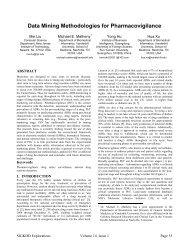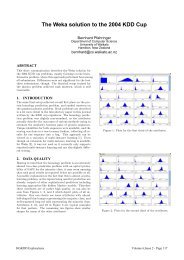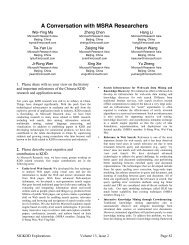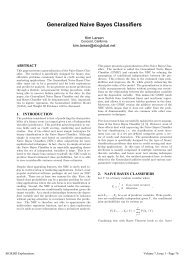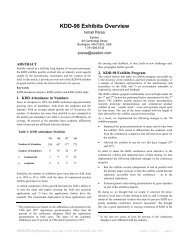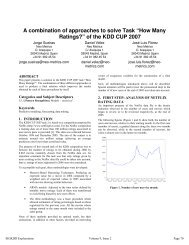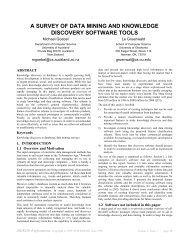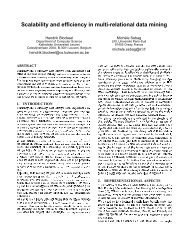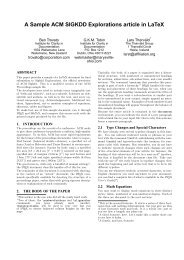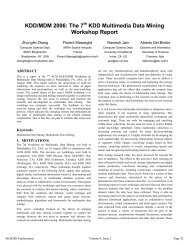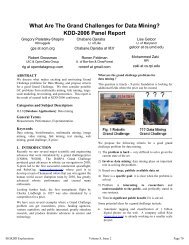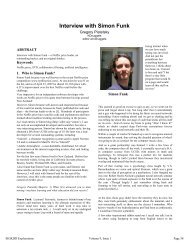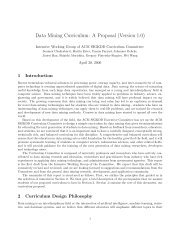Data Mining Using Matrices and Tensors - Florida International ...
Data Mining Using Matrices and Tensors - Florida International ...
Data Mining Using Matrices and Tensors - Florida International ...
Create successful ePaper yourself
Turn your PDF publications into a flip-book with our unique Google optimized e-Paper software.
KDD-2009 Workshop Report<br />
DMMT’09: <strong>Data</strong> <strong>Mining</strong> <strong>Using</strong> <strong>Matrices</strong> <strong>and</strong> <strong>Tensors</strong><br />
ABSTRACT<br />
Chris Ding<br />
Comp. Sci. & Eng. Dept.<br />
University of Texas at Arlington<br />
chqding@uta.edu<br />
We provide a summary of the Workshop on <strong>Data</strong> <strong>Mining</strong> <strong>Using</strong><br />
<strong>Matrices</strong> <strong>and</strong> <strong>Tensors</strong> (DMMT’09) held in conjunction<br />
with ACM SIGKDD 2009, on June 28th in Paris, France.<br />
More than 50 people attended the workshop. We report<br />
in detail about the research issues addressed in the talks at<br />
the workshop. More information about the workshop can be<br />
found at http://www.cs.fiu.edu/~taoli/kdd09-workshop.<br />
1. INTRODUCTION<br />
The field of pattern recognition, data mining <strong>and</strong> machine<br />
learning increasingly adapt methods <strong>and</strong> algorithms from<br />
advanced matrix computations, graph theory <strong>and</strong> optimization.<br />
Prominent examples are spectral clustering, non-negative<br />
matrix factorization, Principal component analysis (PCA)<br />
<strong>and</strong> Singular Value Decomposition (SVD) related clustering<br />
<strong>and</strong> dimension reduction, tensor analysis such as 2DSVD<br />
<strong>and</strong> high order SVD, L-1 regularization, etc. Compared to<br />
probabilistic <strong>and</strong> information theoretic approaches, matrixbased<br />
methods are fast, easy to underst<strong>and</strong> <strong>and</strong> implement;<br />
they are especially suitable for parallel <strong>and</strong> distributed-memory<br />
computers to solve large scale challenging problems such<br />
as searching <strong>and</strong> extracting patterns from the entire Web.<br />
Hence the area of data mining using matrices <strong>and</strong> tensors is<br />
a popular <strong>and</strong> growing area of research activities.<br />
This workshop presents recent advances in algorithms <strong>and</strong><br />
methods using matrix <strong>and</strong> scientific computing/applied mathematics<br />
for modeling <strong>and</strong> analyzing massive, high-dimensional,<br />
<strong>and</strong> nonlinear-structured data. One main goal of the workshop<br />
is to bring together leading researchers on many topic<br />
areas (e.g., computer scientists, computational <strong>and</strong> applied<br />
mathematicians) to assess the state-of-the-art, share ideas<br />
<strong>and</strong> form collaborations. We also wish to attract practitioners<br />
who seek novel ideals for applications. In summary, this<br />
workshop strives to emphasize the following aspects:<br />
• Presenting recent advances in algorithms <strong>and</strong> methods<br />
using matrix <strong>and</strong> scientific computing/applied mathematics<br />
• Addressing the fundamental challenges in data mining<br />
using matrices <strong>and</strong> tensors<br />
Tao Li<br />
School of Computer Science <strong>Florida</strong><br />
<strong>International</strong> University<br />
taoli@cs.fiu.edu<br />
• Identifying killer applications <strong>and</strong> key industry drivers<br />
(where theories <strong>and</strong> applications meet)<br />
• Fostering interactions among researchers (from different<br />
backgrounds) sharing the same interest to promote<br />
cross-fertilization of ideas.<br />
• Exploring benchmark data for better evaluation of the<br />
techniques<br />
2. TOPIC AREAS<br />
The Topic areas for the workshop include (but are not limited<br />
to) the following:<br />
Methods <strong>and</strong> algorithms:<br />
• Principal Component Analysis <strong>and</strong> Singular value decomposition<br />
for clustering <strong>and</strong> dimension reduction<br />
• Nonnegative matrix factorization for unsupervised <strong>and</strong><br />
semi-supervised learning<br />
• Spectral graph clustering<br />
• L-1 Regularization <strong>and</strong> Sparsification<br />
• Sparse PCA <strong>and</strong> SVD<br />
• R<strong>and</strong>omized algorithms for matrix computation<br />
• Web search <strong>and</strong> ranking algorithms<br />
• Tensor analysis, 2DSVD <strong>and</strong> high order SVD<br />
• GSVD for classification<br />
• Latent Semantic Indexing <strong>and</strong> other developments for<br />
Information Retrieval<br />
• Linear, quadratic <strong>and</strong> semi-definite Programming<br />
• Non-linear manifold learning <strong>and</strong> dimension reduction<br />
• Computational statistics involving matrix computations<br />
• Feature selection <strong>and</strong> extraction<br />
• Graph-based learning (classification, semi-supervised<br />
learning <strong>and</strong> unsupervised learning)<br />
• Matrix factorization for classification<br />
SIGKDD Explorations Volume 11, Issue 2 Page 77
Application areas:<br />
• Information search <strong>and</strong> extraction from Web<br />
• Text processing <strong>and</strong> information retrieval<br />
• Image processing <strong>and</strong> analysis<br />
• Genomics <strong>and</strong> Bioinformatics<br />
• Scientific computing <strong>and</strong> computational sciences<br />
• Social Networks<br />
3. WORKSHOP OVERVIEW<br />
This DMMT’09 workshop is a continuation of the theme<br />
of SIGKDD 2008 Workshop on <strong>Data</strong> <strong>Mining</strong> using <strong>Matrices</strong><br />
<strong>and</strong> <strong>Tensors</strong> (DMMT’08). DMMT’08 was the first workshop<br />
on this theme held annually with the SIGKDD Conference.<br />
Through the workshop, we expect to bring together leading<br />
researchers on many topic areas (e.g., computer scientists,<br />
computational <strong>and</strong> applied mathematicians) to assess the<br />
state-of-the-art, share ideas <strong>and</strong> form collaborations. We<br />
also wish to attract practitioners who seek novel ideals for<br />
applications.<br />
The program of the workshop included invited talks by Prof.<br />
Lenore Mullin from National Science Foundation <strong>and</strong> SUNY<br />
Albany; Prof. James Raynolds from SUNY Albany; Prof.<br />
Charles Elkan from University of California at San Diego;<br />
<strong>and</strong> Prof. Leiven De Lathauwer from Katholieke Universiteit<br />
Leuven, Belgium. There are also several research paper<br />
presentations. More than 50 people attended the workshop.<br />
The on-line proceedings of the workshop is available<br />
at http://www.cs.fiu.edu/~taoli/kdd09-workshop/.<br />
4. INVITED TALKS<br />
The workshop program is started by an invited talk entitled<br />
”Tensor Decompositions <strong>and</strong> Applications: a Survey”<br />
by Prof. Leiven De Lathauwer from Katholieke Universiteit<br />
Leuven, Belgium. Dr. Lathauwer is the developer of High-<br />
Order SVD (HOSVD). He gave a survey on tensor generalizations<br />
of the Singular Value Decomposition (SVD) <strong>and</strong><br />
their applications. He also discussed some developments on<br />
Nonnegative Tensor Factorizations.<br />
Prof. Charles Elkan from University of California at San<br />
Diego also gave an invited talk on factorizing matrices with<br />
missing entries. The known algorithms for approximate factorization<br />
of large matrices are so diverse that the multiple<br />
approaches have never been explained in one place, <strong>and</strong> have<br />
never been fully compared experimentally. Charles outlined<br />
the available alternatives, focusing especially on experimental<br />
results, on methods for factorizing matrices with unknown<br />
entries, <strong>and</strong> on methods based on stochastic gradient<br />
descent.<br />
Prof. Lenore Mullin <strong>and</strong> Prof. James Raynolds gave a joint<br />
invited talk entitled ”<strong>Tensors</strong> <strong>and</strong> n-d Arrays: Mathematics<br />
of Arrays, Psi-Calculus, <strong>and</strong> Composition of Tensor <strong>and</strong><br />
Array Operations”. Prof. Mullin is currently a program<br />
director for Algorithmic Foundations (AF) in Division of<br />
Computing <strong>and</strong> Communication Foundations (CCF) of Directorate<br />
for Computer & Information Science & Engineering<br />
(CISE) at National Science Foundation (NSF). They discussed<br />
the outer product/tensor product <strong>and</strong> a special case<br />
of the tensor product: the Kronecker product, along with<br />
optimal implementation when composed, <strong>and</strong> mapped to<br />
complex processor/memory hierarchies. They also demonstrated<br />
that how the use of “A Mathematics of Arrays”<br />
(MoA), <strong>and</strong> the psi-Calculus, (a calculus of indexing with<br />
shapes), provides optimal, verifiable, reproducible, scalable,<br />
<strong>and</strong> portable implementations of both hardware <strong>and</strong> software.<br />
5. OVERVIEW OF THE RESEARCH PRE-<br />
SENTATIONS<br />
The workshop program included several research presentations.<br />
In their paper, Frank Nielsen (Ecole Polytechnique, France<br />
& Sony CSL, Japan) <strong>and</strong> Aurelien Ser<strong>and</strong>our (Ecole Polytechnique,<br />
France) presented an empirical comparison of<br />
various distance metric-learning algorithms including optimization<br />
based metric learning <strong>and</strong> information theoretic<br />
metric learning using six UCI datasets. The study indicated<br />
that the performance results of the algorithms are<br />
largely dependent on the data characteristics (e.g., size, dimensions).<br />
It appears that no algorithm tends to dominate<br />
the other ones. Furthermore, results on well-defined sets<br />
may not represent the behavior on human-built ones. In<br />
summary, the study demonstrates the difficulty of distance<br />
learning <strong>and</strong> calls for more work to address various research<br />
challenges.<br />
Eman Abdu <strong>and</strong> Douglas Salane from the City University of<br />
New York presented a spectral-based algorithm, SCCADDS<br />
(Spectral-based Clustering algorithm for CAtegorical <strong>Data</strong><br />
using <strong>Data</strong> Summaries), for clustering categorical data that<br />
combines attribute relationship <strong>and</strong> dimension reduction techniques<br />
found in Principal Component Analysis (PCA) <strong>and</strong><br />
Latent Semantic Indexing (LSI). SCCADDS uses data summaries<br />
that consist of attribute occurrence <strong>and</strong> co-occurrence<br />
frequencies to create a set of vectors each of which represents<br />
a cluster <strong>and</strong> also utilizes spectral decomposition of the data<br />
summaries matrix to project <strong>and</strong> cluster the data objects in<br />
a reduced space. Comparing with existing spectral clustering<br />
methods, SCCADDS has several new features: 1) It uses<br />
the attribute categories similarity matrix instead of the data<br />
object similarity matrix <strong>and</strong> can scale well for large datasets<br />
since in most categorical clustering applications the number<br />
of attribute categories is small relative to the number of data<br />
objects; 2) It clusters the data objects directly by comparing<br />
them to c<strong>and</strong>idate cluster representatives without the need<br />
for an iterative clustering method; <strong>and</strong> 3) Its complexity is<br />
linear in terms of the number of data objects. Experiments<br />
were conducted to demonstrate the effectiveness of the proposed<br />
method.<br />
Mikhail Krivenko <strong>and</strong> Vitaly Vasilyev from the Institute of<br />
Informatics Problems of the Russian, Academy of Sciences,<br />
Moscow presented their work on sequential latent semantic<br />
indexing (SLSI). The main difference of the SLSI from the<br />
existing sequential algorithms is that the dimension of space<br />
is not fixed <strong>and</strong> dynamically changes to ensure a given level<br />
SIGKDD Explorations Volume 11, Issue 2 Page 78
of relative approximation error of a matrix of observations.<br />
The authors provided theoretical <strong>and</strong> experimental justification<br />
of the effectiveness of the proposed method. The<br />
experiments with the different collections of texts demonstrated<br />
that the SLSI algorithm could be seen as a tradeoff<br />
solution, which have a lower computational complexity <strong>and</strong><br />
memory requirements compared to the st<strong>and</strong>ard LSI method<br />
<strong>and</strong> did not lead to a decrease of the quality of classification<br />
in contrast to other sequential algorithms.<br />
In their work, Elisabeth Georgii (MPI for Biological Cybernetics/Friedrich<br />
Miescher Laboratory, Germany), Koji<br />
Tsuda (MPI for Biological Cybernetics, Germany), <strong>and</strong> Bernhard<br />
Scholkopf (MPI for Biological Cybernetics, Germany)<br />
described an an enumerative approach called DCE (Dense<br />
Cluster Enumeration) to identify dense clusters in tensors of<br />
arbitrary dimensionality. The density criterion is exploited<br />
in an effective way using a reverse search algorithm. In addition,<br />
DCE ranks the results by exact p-values <strong>and</strong> can deal<br />
with symmetry constraints. Compared to methods that coanalyze<br />
multiple networks, DCE is more general <strong>and</strong> flexible,<br />
allowing to analyze tensor data with an arbitrary number of<br />
dimensions, real or binary values, including symmetries or<br />
not. In addition, the size of the solution set of DCE can be<br />
controlled by tuning the density threshold <strong>and</strong> the weight<br />
distribution or sparsity of the tensor. The authors also discussed<br />
their future work on improving the efficiency of DCE<br />
for large-scale applications <strong>and</strong> on integrating background<br />
knowledge.<br />
Mario Navas <strong>and</strong> Carlos Ordonez from University of Houston<br />
studied how to leverage a DBMS computing capabilities<br />
to solve Principal Component Analysis (PCA). They proposed<br />
a solution that combines a summarization of the data<br />
set with the correlation or covariance matrix <strong>and</strong> then solves<br />
PCA with Singular Value Decomposition (SVD). Deriving<br />
the summary matrices allow analyzing large data sets since<br />
they can be computed in a single pass. They introduced<br />
two solutions for solving SVD without external libraries:<br />
one based in SQL queries <strong>and</strong> a second one based on User-<br />
Defined Functions. Experimental evaluation demonstrated<br />
that their proposed method can solve larger problems in less<br />
time than external statistical packages.<br />
Chris Ding from UT Arlington presented some recent theoretical<br />
progress in tensor clustering <strong>and</strong> error Bounds. He<br />
<strong>and</strong> his colleagues recently developed theoretical proof to<br />
show that the widely used ParaFac <strong>and</strong> HOSVD tensor decompositions<br />
are in fact performing simultaneous K-means<br />
data clustering <strong>and</strong> subspace factorization. This work extends<br />
the earlier development on the equivalence between K-<br />
means clustering <strong>and</strong> principal component analysis (PCA),<br />
<strong>and</strong> the equivalence between K-means clustering <strong>and</strong> nonnegative<br />
matrix factorization (NMF). They also presented<br />
lower <strong>and</strong> upper bounds on the tensor reconstruction errors,<br />
similar to the Eckart-Young error formulation for Singular<br />
Value decomposition (SVD). Experiments on 3 image<br />
datasets are presented.<br />
6. WORKSHOP ORGANIZATION<br />
Work Co-chairs<br />
Chris Ding, University of Texas at Arlington<br />
Tao Li, <strong>Florida</strong> <strong>International</strong> University<br />
Committee Members<br />
Tammy Kolda, S<strong>and</strong>ia National Labs<br />
Jesse Barlow, Penn State University<br />
Michael Berry, University of Tennessee<br />
Yun Chi, NEC Laboratories America<br />
Lars Elden, Linkping University, Sweden<br />
Christos Faloutsos, Carnegie Mellon University<br />
Estratis Gallopoulos, University of Patras<br />
Joydeep Ghosh, University of Texas at Austin<br />
Ming Gu, University of California, Berkeley<br />
Michael Jordan, University of California, Berkeley<br />
Yuanqing Lin, University of Pennsylvania<br />
Huan Liu, Arizona State University<br />
Michael Ng, Hong Kong Baptist University<br />
Haesun Park, Georgia Tech<br />
Wei Peng, Xerox Research<br />
Robert Plemmons, Wake Forest<br />
Alex Pothen, Old Domino University<br />
Yousef Saad, University of Minnesota<br />
Horst Simon, Lawrence Berkeley National Laboratory<br />
Fei Wang, <strong>Florida</strong> <strong>International</strong> University<br />
Jieping Ye, Arizona State University<br />
Kai Yu, NEC Laboratories America<br />
Hongyuan Zha, Georgia Tech<br />
Zhongyuan Zhang, Central University of Finance & Economics<br />
Shenghuo Zhu, NEC Laboratories America<br />
Most submissions were reviewed <strong>and</strong> discussed by two reviewers<br />
<strong>and</strong> workshop co-chairs. We are very indebted to<br />
all program committee members who helped us organize<br />
the workshop <strong>and</strong> reviewed the papers very carefully. We<br />
would also like to thank all the authors who submitted<br />
their papers to the workshop; they provided us with an<br />
excellent workshop program. More information about the<br />
workshop can be found at http://www.cs.fiu.edu/~taoli/<br />
kdd09-workshop/.<br />
SIGKDD Explorations Volume 11, Issue 2 Page 79



